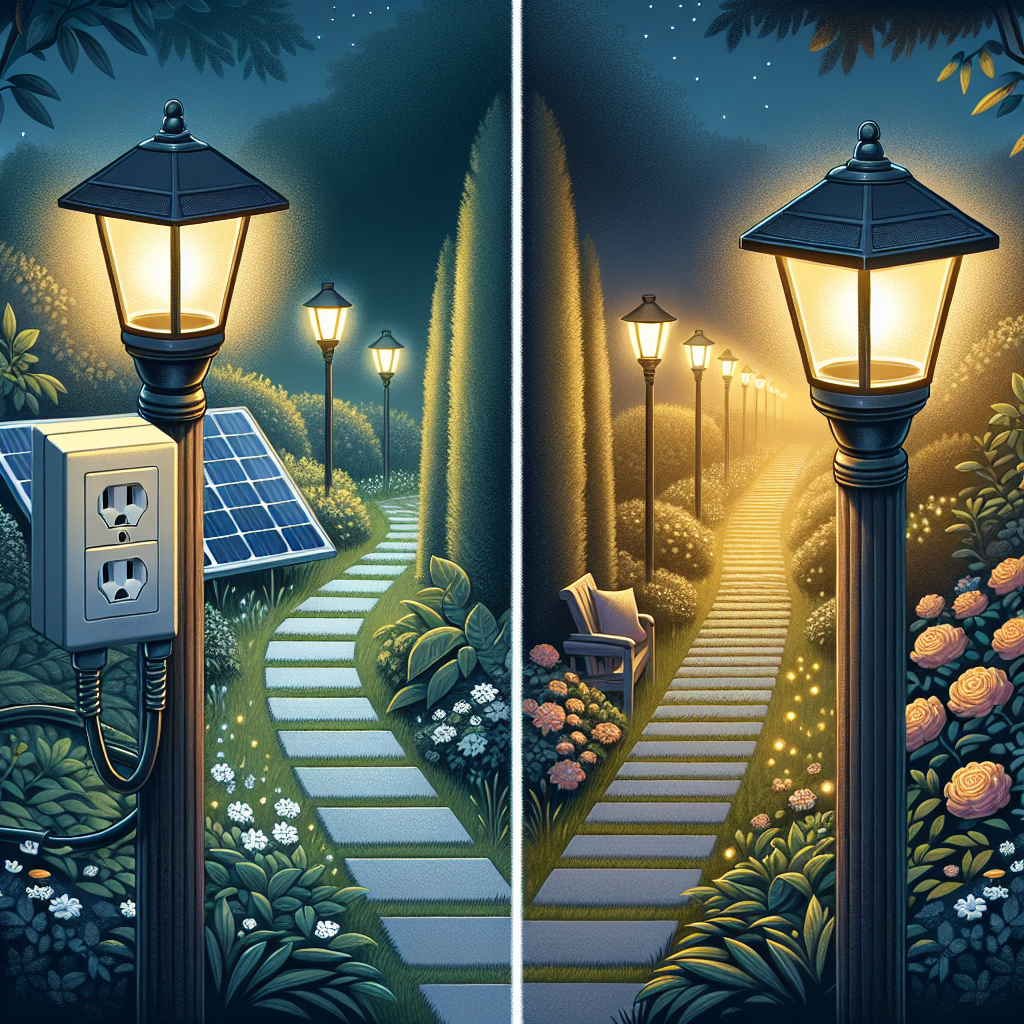Solar Path Lights vs Traditional Outdoor Lighting
Table of Contents
Solar path lights and traditional outdoor lighting represent two distinct approaches to illuminating outdoor spaces. Solar path lights harness the power of the sun, converting sunlight into energy through photovoltaic cells, which is then stored in batteries for nighttime use. They are eco-friendly, cost-effective over time, and easy to install since they require no wiring. On the other hand, traditional outdoor lighting typically relies on electrical power from the grid, offering consistent and often brighter illumination. These lights can be more reliable in areas with limited sunlight but may incur higher energy costs and require professional installation. Each option has its own set of advantages and limitations, making the choice dependent on specific needs and environmental considerations.
Cost Comparison: Solar Path Lights vs Traditional Outdoor Lighting
When considering outdoor lighting options, the cost is a significant factor that influences the decision-making process. Solar path lights and traditional outdoor lighting each come with their own set of financial implications, both in terms of initial investment and long-term expenses. To make an informed choice, it is essential to compare these two options comprehensively.
Initially, the upfront costs of solar path lights tend to be higher than those of traditional outdoor lighting. Solar lights incorporate advanced technology, including photovoltaic cells, rechargeable batteries, and LED bulbs, which contribute to their higher price point. In contrast, traditional outdoor lighting, which typically relies on incandescent or halogen bulbs, is generally less expensive to purchase. However, this initial cost difference is only one aspect of the overall financial picture.
Transitioning to the operational costs, solar path lights offer a distinct advantage. Since they harness energy from the sun, they do not incur any electricity costs. This can result in substantial savings over time, especially in areas with high electricity rates. Traditional outdoor lighting, on the other hand, requires a continuous supply of electricity, leading to ongoing utility expenses. These costs can accumulate significantly, particularly if the lights are used extensively or left on for long periods.
Moreover, maintenance costs also play a crucial role in the cost comparison. Solar path lights are generally low-maintenance, as they have fewer components that can fail. The LED bulbs used in solar lights have a long lifespan, often lasting up to 50,000 hours, which reduces the frequency of replacements. Additionally, the rechargeable batteries in solar lights typically last for several years before needing replacement. In contrast, traditional outdoor lighting systems may require more frequent bulb replacements and maintenance of electrical wiring, which can add to the overall cost.
Furthermore, installation costs must be considered. Solar path lights are relatively easy to install, as they do not require any wiring or connection to the electrical grid. This simplicity can result in lower installation costs, as homeowners can often install the lights themselves without the need for professional assistance. Traditional outdoor lighting, however, often necessitates professional installation, especially if it involves complex wiring or integration with existing electrical systems. This can lead to higher labor costs and additional expenses for materials.
In addition to these direct costs, it is also important to consider the environmental and long-term financial benefits of solar path lights. By utilizing renewable energy, solar lights contribute to a reduction in greenhouse gas emissions and reliance on fossil fuels. This not only benefits the environment but can also lead to potential savings through government incentives or rebates for using renewable energy sources. Traditional outdoor lighting, which relies on electricity generated from non-renewable sources, does not offer these environmental or financial advantages.
In conclusion, while the initial cost of solar path lights may be higher than that of traditional outdoor lighting, the long-term savings in operational and maintenance costs, coupled with the ease of installation and environmental benefits, make them a cost-effective choice in the long run. Traditional outdoor lighting may have a lower upfront cost, but the ongoing expenses and potential for higher maintenance needs can offset these initial savings. Therefore, when evaluating the cost comparison between solar path lights and traditional outdoor lighting, it is essential to consider both the immediate and long-term financial implications to make a well-informed decision.
Environmental Impact: Solar Path Lights vs Traditional Outdoor Lighting

When considering the environmental impact of solar path lights versus traditional outdoor lighting, it is essential to examine various factors, including energy consumption, carbon footprint, and resource utilization. Solar path lights, which harness energy from the sun, offer a sustainable alternative to conventional lighting systems that rely on electricity generated from fossil fuels. This distinction is crucial in understanding the broader environmental implications of each lighting option.
To begin with, solar path lights operate by converting sunlight into electrical energy through photovoltaic cells. This process is inherently clean and renewable, as it does not produce greenhouse gas emissions or other pollutants. In contrast, traditional outdoor lighting typically depends on electricity from the grid, which is often generated by burning coal, natural gas, or oil. The combustion of these fossil fuels releases significant amounts of carbon dioxide and other harmful substances into the atmosphere, contributing to climate change and air pollution.
Moreover, the energy efficiency of solar path lights further enhances their environmental benefits. These lights are designed to store energy during the day and use it at night, ensuring minimal energy wastage. On the other hand, traditional outdoor lighting systems can be less efficient, especially if they are left on for extended periods or use outdated technology. The inefficiency of these systems not only leads to higher energy consumption but also increases the demand for electricity, thereby exacerbating the environmental impact associated with power generation.
In addition to energy consumption, the production and disposal of lighting equipment also play a significant role in their environmental footprint. Solar path lights are generally made from materials that are more environmentally friendly and easier to recycle compared to traditional lighting fixtures. For instance, many solar lights use LED bulbs, which have a longer lifespan and lower energy requirements than incandescent or fluorescent bulbs commonly found in traditional systems. The extended lifespan of LED bulbs reduces the frequency of replacements, thereby decreasing the amount of waste generated.
Furthermore, the installation and maintenance of solar path lights are less invasive to the environment. Since these lights do not require extensive wiring or connection to the electrical grid, their installation process is simpler and less disruptive to the surrounding landscape. This contrasts with traditional outdoor lighting, which often necessitates digging trenches and laying cables, potentially disturbing local ecosystems and habitats.
Another critical aspect to consider is the resource utilization associated with each lighting option. Solar path lights rely on the abundant and renewable energy of the sun, making them a more sustainable choice in the long term. Conversely, traditional outdoor lighting depends on finite fossil fuel resources, which are becoming increasingly scarce and environmentally damaging to extract. The extraction, transportation, and processing of these fuels contribute to habitat destruction, water pollution, and other ecological issues.
In conclusion, when evaluating the environmental impact of solar path lights versus traditional outdoor lighting, it becomes evident that solar path lights offer a more sustainable and eco-friendly solution. Their reliance on renewable energy, higher energy efficiency, and reduced resource utilization make them a preferable choice for minimizing environmental harm. As society continues to seek ways to mitigate climate change and reduce ecological footprints, the adoption of solar path lights represents a significant step towards achieving these goals.
Installation and Maintenance: Solar Path Lights vs Traditional Outdoor Lighting
When considering the installation and maintenance of outdoor lighting, it is essential to weigh the differences between solar path lights and traditional outdoor lighting. Both options offer unique advantages and challenges, which can significantly impact the overall experience and long-term satisfaction of homeowners and property managers.
To begin with, the installation process for solar path lights is notably straightforward. These lights are typically designed to be user-friendly, requiring minimal tools and expertise. Most solar path lights come with a simple stake that can be easily inserted into the ground, making them an ideal choice for those who prefer a do-it-yourself approach. Additionally, because solar path lights are powered by the sun, there is no need for complex wiring or electrical connections. This not only reduces the risk of electrical hazards but also eliminates the need for professional installation services, thereby saving on labor costs.
In contrast, traditional outdoor lighting often necessitates a more involved installation process. These lights usually require a connection to the electrical grid, which means that wiring must be laid out and connected properly. This task often demands the skills of a licensed electrician to ensure safety and compliance with local electrical codes. Furthermore, the installation of traditional outdoor lighting may involve digging trenches to bury the wires, which can be labor-intensive and disruptive to the landscape. Consequently, the initial setup for traditional outdoor lighting can be both time-consuming and costly.
Moving on to maintenance, solar path lights generally require less upkeep compared to their traditional counterparts. Since they are powered by solar energy, there are no ongoing electricity costs. The primary maintenance task involves periodically cleaning the solar panels to ensure they receive maximum sunlight. Additionally, the LED bulbs used in most solar path lights have a long lifespan, often lasting several years before needing replacement. However, it is worth noting that the performance of solar path lights can be affected by weather conditions and the amount of sunlight they receive. In areas with limited sunlight or frequent overcast days, the lights may not perform optimally.
On the other hand, traditional outdoor lighting systems demand more regular maintenance. The bulbs in these systems typically have a shorter lifespan compared to LEDs and may need to be replaced more frequently. Moreover, because traditional outdoor lights are connected to the electrical grid, there is a potential for issues such as wiring faults or power outages, which can necessitate professional repairs. Additionally, traditional outdoor lighting systems incur ongoing electricity costs, which can add up over time, especially if the lights are used extensively.
In conclusion, the choice between solar path lights and traditional outdoor lighting hinges on several factors, including ease of installation, maintenance requirements, and long-term costs. Solar path lights offer a simpler installation process and lower maintenance demands, making them an attractive option for those seeking a hassle-free lighting solution. However, their performance can be influenced by environmental conditions. Traditional outdoor lighting, while more complex and costly to install and maintain, provides consistent performance regardless of weather conditions. Ultimately, the decision will depend on individual preferences, budget considerations, and the specific needs of the outdoor space in question.
Read more about Solar Path Lights:
- Benefits of Solar Path Lights
- How to Choose the Right Solar Path Lights
- Installing Solar Path Lights
- Maintaining Solar Path Lights
- Creative Ways to Use Solar Path Lights in Your Outdoor Space
- Troubleshooting Common Issues with Solar Path Lights
- Maximizing the Lifespan of Solar Path Lights
- Solar Path Lights for Commercial Use
- Solar Path Lights in Different Climates and Locations








